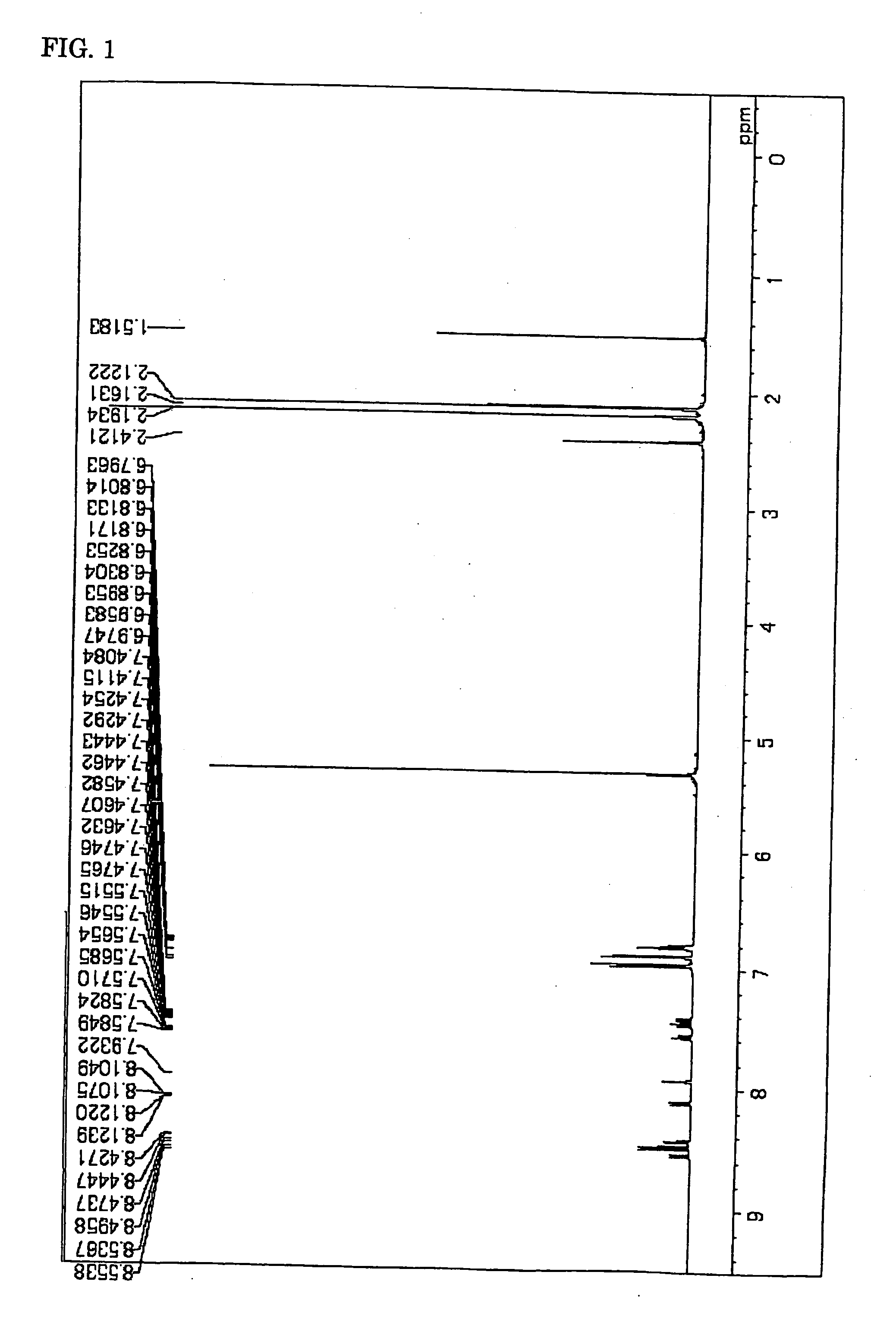Aromatic amine derivative and organic electroluminescence device employing the same
- Summary
- Abstract
- Description
- Claims
- Application Information
AI Technical Summary
Benefits of technology
Problems solved by technology
Method used
Image
Examples
synthesis example 1
Synthesis of Chemical Compound (4)
(1-1) Synthesis of 2-bromo-6-methylnaphthalene
[0199] Under an atmospheric argon gas flow, trifluoromethane sulfonic acid-6-bromo-2-naphthyl ester in an amount of 32 g (90 mmol), dichloro(diphenylphosphinoferrocene)palladium in an amount of 3.6 g (5% by mol), lithium bromide in an amount of 7.8 g (90 mmol) and desiccated tetrahydrofuran in an amount of 100 milliliter were placed into a three neck flask with cooling pipe and having a capacity of 500 milliliter, and then, the resultant solution was cooled down to −20° C. After slowly dripping methylmagnesiumbromide in an amount of 90 milliliter (90 mmol, 1 mol / liter (tetrahydrofuran)) into the flask, the resultant solution was stirred under heating at the temperature of 80° C. for 4 hours. After the reaction terminated, adding dilute hydrochloric acid in an amount of 100 milliliter into the reacted solution, an organic layer was separated and washed with the use of sodium bicarbonate solution and sod...
synthesis example 2
Synthesis of Compound (9)
(2-1) Synthesis of 2-isopropyl-6,12-dibromo chrysene
[0206] An aimed compound was obtained in a similar manner as Synthesis Example 1 from the step (1-1) to the step (1-5) except that isopropylmagnesium bromide was employed instead of methylmagnesium bromide in the step (1-1).
(2-2) Synthesis of Compound (9)
[0207] Under an atmospheric argon gas flow, 2-isopropyl-6,12-dibromochrysene in an amount of 4.2 g (10 mmol), 4-isopropylphenyl-p-tolyl amine in an amount of 5.6 g (25 mmol), palladium acetate in an amount of 0.03 g (1.5% by mol), tri-t-butylphosphine 0.06 g (3% by mol), t-butoxy sodium in an amount of 2.4 g (25 mmol) and desiccated toluene in an amount of 100 milliliter were placed into a three-necked flask equipped with a cooling pipe and having a capacity of 300 milliliter, and the resultant solution was stirred under heating at a temperature of 100° C. for one night. After the reaction terminated, precipitated crystals were separated by filtration a...
synthesis example 3
Synthesis of Chemical Compound (20)
(3-1) Synthesis of 2-bromo-6-isopropylnaphthalene
[0209] Under an atmospheric argon gas flow, trifluoromethane sulfonic acid-6-bromo-2-naphthyl ester in an amount of 32 g (90 mmol), dichloro(diphenylphosphinoferrocene)palladium in an amount of 3.6 g (5% by mol), lithium bromide in an amount of 7.8 g (90 mmol) and desiccated tetrahydrofuran in an amount of 100 milliliter were placed into three necked-flask equipped with cooling pipe and having a capacity of 500 milliliter, and then, the resultant solution was cooled down to −20° C. After slowly dripping isopropylmagnesiumbromide in an amount of 90 milliliter (90 mmol, 1 mol / liter (tetrahydrofuran)) into the flask, the resultant solution was stirred under heating at the temperature of 80° C. for 4 hours. After the reaction terminated, adding dilute hydrochloric acid in an amount of 100 milliliter into the reacted solution, an organic layer was separated and washed with the use of sodium bicarbonate ...
PUM
| Property | Measurement | Unit |
|---|---|---|
| Percent by mass | aaaaa | aaaaa |
| Weight | aaaaa | aaaaa |
Abstract
Description
Claims
Application Information
 Login to View More
Login to View More - R&D
- Intellectual Property
- Life Sciences
- Materials
- Tech Scout
- Unparalleled Data Quality
- Higher Quality Content
- 60% Fewer Hallucinations
Browse by: Latest US Patents, China's latest patents, Technical Efficacy Thesaurus, Application Domain, Technology Topic, Popular Technical Reports.
© 2025 PatSnap. All rights reserved.Legal|Privacy policy|Modern Slavery Act Transparency Statement|Sitemap|About US| Contact US: help@patsnap.com



